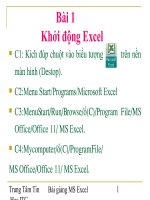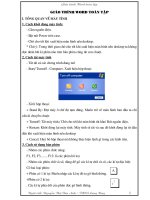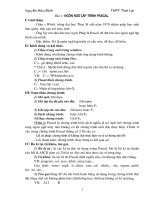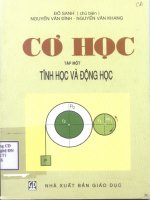giáo trình zhong wen - tập 2
Bạn đang xem bản rút gọn của tài liệu. Xem và tải ngay bản đầy đủ của tài liệu tại đây (7.06 MB, 132 trang )
中文 2
监制制:
中华人民共和国国务院侨务办公室
监制人:
刘泽彭
顾制问:
(按姓氏笔画排列)
王建军 王满霞 刘 辉 许 易 李允晨
李珊英 杨八林 杨启光 何振宇 陈光磊
周小兵 郑良根 赵金铭 班 弨 郭 熙
黄 磊 彭 俊 蒋述卓 雷振刚 蔡昌杰
颜长城 潘兆明
主制编:
贾益民
副主编:
吴晓明 常芳清
编制写:
(按姓氏笔画排列)
干红梅 于 珊 王 劼 刘潇潇 刘 慧
许迎春 孙清忠 李 艳 吴玉峰 吴晓明
何慧宜 张凤芝 张雪芹 周 琴 赵晓艳
胡建刚 贾益民 郭楚江 谈颖瑜 黄年丰
常芳清 梁 静 董 斌 潘 莉 戴 薇
英文翻译:
戴 薇
责任编辑:
李 战 沈凤玲 黄圣英 陈鸿瑶 黄 倩
吕肖剑 杜小陆
责任校对:
陈 涛 侯丽庆 梁吉平 黄海燕 周玉宏
美术编辑:
李海燕
图书在版编目(CIP)数据
中文·第二册(修订版) / 中国暨南大学华文学院,华文教育研究所编.
广州:暨南大学出版社,2006.12
ISBN7-81029-636-1
Ⅰ. 中…
Ⅱ. ①中…②华…
Ⅲ. 对外汉语教学
Ⅳ.H195
监制:中华人民共和国国务院侨务办公室
(中国·北京)
监制人:刘泽彭
电话 / 传真:0086
-
10
-
68320122
编写:中国暨南大学华文学院 华文教育研究所
(中国·广州)
电话 / 传真:0086-20-87206866
出版 / 发行:暨南大学出版社
(中国·广州)
电话 / 传真:0086-20-85221583
印制:
1997 年 6 月第 1 版 2006 年 12 月第 2 版 2006 年 12 月第 次印刷
787mm×1092mm1/168.375 印张
版权所有 翻印必究
中文 2
修订版前言
《中文》(试用版)教材是1996年由中华人民共和国国务院侨务办公室委托暨南大学华
文学院为海外华侨、华人子弟学习中文而编写的。全套教材共48册,其中《中文》主课本
12册,家庭练习册24册(分为A、B册),教师教学参考书12册。这套教材自1997年6月陆续
出版,直到1999年11月全部出齐,迄今已发行560多万册,但仍供不应求。2000—2003年,
我们又接受国务院侨务办公室委托,先后研制了与本教材配套的多媒体教学光盘 《中文》
及网络版教材《网上学中文》( 见 中国侨网:http://www.chinaqw.com,暨南大学华文学院
网站:http://hwy.jnu.edu.cn), 同时又将 《中文》 改 编为繁体字版教材,一并发行使用,
深受海外华文教师、学生及其家长的欢迎和好评。
这次 《中文》教材的修订是中华人民共和国国务院侨务办公室委托暨南大学华文学
院、华文教育研究所在原 《中文》教材试用版的基础上,总结自1997年以来的试用情况,
结合海外华文教育的实际需要和特点,广泛听取各方面意见和建议,以教材研究为依据修
订再版的。修订再版的《中文》教材全套共52册,除原有的48册外,另增编了配套的《学
拼音》课本1册、《学 拼音练习册》 2 册 及 《学 拼音教学参考》 1 册。
本教材的教学目的是使学生经过全套中文教材的学习与训练,具备汉语普通话听、
说、读、写的基本能力,了解中华文化常识,为进一步学习中国语言文化打下良好的
基础。
在修订编写过程中,我们根据海外华文教育的目标要求,从教学对象的年龄、生活环
境和心理特点出发,以中国国家对外汉语教学领导小组办公室汉语水平考试部编制的《汉
语水平等级标准与语法等级大纲》( 1996)、中国国家汉语水平考试委员会办公室考试中心制
定的《汉语水平词汇与汉字等级大纲》( 2001)和中国国家语委、国家教委公布的《现代汉
语常用字表》( 1988) 等为依据或参考,科学地安排教材的字、词、句、篇章等内容,由浅
入深、循序渐进地设置家庭练习,以期教学相长、学以致用,培养学生的学习兴趣,启发
学生积极思考,提高学生运用中文的能力。同时,我们对海外现有中文教材进行了深入的
分析研究,参考和借鉴了许多有益的经验,力求使教材达到教与练、学与用的统一,并在
教材内容与体例、图文编排、题型设计以及教学理念的体现等方面有所创新。
现将修订中的有关问题作如下说明:
一、根据海外中文(华文)学校的课时情况,修订后的《中文》教材每册由原来的14
课调整为12课,并适当降低了课文难度。每3课为1个单元,每册共有4个单元。每个单元附
有综合练习,每册增加了总练习。每册教材均附录音序生词表,该表收录本册各课所有生
词 (含单音节词和多音节词)。 生 词 右 下 角 标 注 课文序号。
二、修订版教材第1册第1~6课为识字课,主课文后只列生字,不列词语和句子;自第
中文 2
1
中文 2
7课开始,主课文后列词语和句子,但只列双音节或多音节词语,单音节词不列入;部分
主课文后还列有“专有名词”,如人名、地名、国名等。
三、为了方便教学,修订版中文教材另配有 《学 拼音》 及配套练习册,故1~12册主
教材不含现代汉语拼音教学内容,但自第5册开始,适当增加了部分拼音练习。
四、修订版教材第1~4册的主课文、阅读课文均加注现代汉语拼音,从第5册开始,
只为生字注音。注音时除主课文后的“词语”和“专有名词”按词注音外,其余部分均
按字注音,一般标本调,但几类轻声不标声调。一般轻读、间或重读的字,注音上标调
号。
此外,“一”“不”在课文中按实际读音标注声调。
五、儿化的处理。凡书面上可以不儿化的,不作儿化处理,但有拼音时则加注儿化
音;非儿化不可的,则将“儿”字放在词后,如“这儿”“一会儿”等。
六、为了方便学生学习,修订版中文教材及练习册的课文题目、练习题目等配有英
文翻译或解释。部分“专有名词”在 《中文教学参考》中加注了英文名称。
七、新出现的笔画或部首均在课文生字栏下列出,但识字课只列笔画,不列部首。
1~4册课堂练习中的“描一描,写一写”,凡生字均按笔顺逐一列出笔画,并将笔画书写
方向用红色箭头标出。从第5册开始,课堂练习的生字不再按笔顺列出笔画。笔顺规范依
据中国国家语委、新闻出版总署颁布的《现代汉语通用字笔顺规范》( 1997)。
八 、为方便阅读课文的教学和自学,修订版中文教材在阅读课文后增加了“生字”
“词语”,部分列有“专有名词”,并相应地在 《中文教学参考》中增加了阅读课文的教学
参考内容。
九、为了适应部分学生认读繁体字的需要,修订版教材在主课本之后附有“简繁对
照”的音序生字表,并在生字右下角标出课文序号。自第2册开始,各册均收录前面各册
教材的音序生字表,以方便查阅。本教材所列繁体字依据中国国家语委颁布的《简化字
总表》( 1986), 该 表 附录中所列异体字已停止使用,故本教材不再作为繁体字或异体字收
录。繁体字字形均采用新字形。《中文教学参考》中也相应地增加了繁体字的教学参考
内容。此外,1~6册教材附设有生字卡片,以方便教学。
十、为培养学生的汉语交际能力,修订版中文教材在原有的基础上进一步加强了汉
语交际功能训练。
本教材的修订再版得到了国内一些知名的语言学专家、汉语教学专家和在海外从事
中文教学与研究的学者的热情指导,对此我们表示诚挚的谢意。
由于修订时间紧促,本教材仍会存在某些疏漏之处,祈盼各位专家、学者及广大教
师不吝赐教。
主编 贾益民
2006年6月28日
中文 2
2
Preface
Zhongwen (MandarinChineseLanguage)
coursematerialsoftrialeditionwere
writtenforoverseasChineseandtheirchildrenin1996byCollegeofChinese
LanguageandCulture,JinanUniversity,underthecommissionofOverseasChinese
AffairsOfficeoftheStateCouncilofPeople
蒺
sRepublicofChina.Theentirecourse
materialsconsistof48books,including12textbooks,24exercisebooks(bookAand
bookB),and12teach
er蒺sreferencebooks.P
ublicationstartedinJune,1997and
completedinNovember,1999withmorethan5.6millioncopiesdistributeduptothis
day.However,supplywasnotabletokeepupwithdemand.Between2000and2003,
entrustedbyOverseasChineseAffairsOfficeoftheStateCouncilofPeople
蒺
sRepublic
ofChina,wedevelopedteacher
蒺
s
Zhongwen
VCDandonlineedition
ChineseOnline
(see www.chinaqw.com orhttp://hwy.jnu.edu.cn),andarrangedatraditionalChinese
characteredition.AlltheseproductshavegainedawidepopularityamongChinese
languageteachers,studentsandtheirparentsabroad.
Thisrevisionof
Zhongwen
materialswasauthorizedbyOverseasChineseAffairs
OfficeoftheStateCouncilofP.R.ChinatoCollegeofChineseLanguageandCulture
andEducationInstituteofChineseLanguageandCulture,JinanUniversity.This
revisededitionreflectsactualneedsandcharacteristicsofoverseasChineselanguage
educationandtakesinconstructiveadvicefrommanysidesandresearchfindingson
languageteachingandtextbookstudies.Theneweditionof
Zhongwen
isnowa
collectionof52books,withadditionalfourbooks-one
StudyPinyin
textbook,two
StudyPinyin
exercisebooksandone
StudyPinyin
teacher
蒺
sreferencebook-tothe
original48books.
Theinstructionalgoalof
Zhongwen
istoenablestudentstoacquirebasic
listening,speaking,readingandwritingcapabilitiesofPutonghua(MandarinChinese)
throughaprocessoflearningandtraining,toexposestudentstoChinesecultureand
layasolidgroundfortheirfurtherstudyofChineselanguageandculture.
Therevisionwascarriedoutundertheguidelinesof
StandardofChinese
Language LevelandGeneralOutline ofChineseGrammar
(1996)issuedby
中文 2
3
中文 2
DepartmentofTestingAffairsofChinaNationalOfficeforTeachingChineseasa
ForeignLanguage(NOCFL),
GeneralOutlineofChineseLanguageLevelofGlossaries
andCharacters
(2001)issuedbyChinaNationalCommitteeforChineseProficiencyTest
(HSK),and
ListofFrequentlyUsedCharactersinModernChinese
(1988)issued
jointlybyStateLanguageCommissionandMinistryofEducationofChina.Basedonall
above,anefforthasbeenmadeatenhancinglearningexperienceanddevelopmentwith
acarefulchoiceofcharacters,words,sentences,andtexts.Thehomeworkexercisehas
beenmodifiedandarrangedinorderofincreasingdifficultiesandadvancement.These
improvementsareexpectedtobeofenormousbenefitstobothteachersandstudents
alike,inimprovingtheirChineselanguageskills,raisingtheirlearningmotivation,
stimulatingtheiractivethinkingandincreasingtheiroverallproficiencyintheuseof
Chineselanguage.Meanwhile,extensiveresearchwasmadeintheexistingChinese
textbooksthatareusedoverseaswhichprovidedmuchhelpfulexperiencetothe
revision.Therevisededitioncloselyintegratesinstructionandpractice,learningand
application.Creativeinnovationshavebeenincorporatedinthecoursecontent,general
arrangements,pagedesign,questionformatandinstructionalconcepts.
Thefollowingisasummaryofmajorchangesincludingreorganization,deletionand
additionofnewmaterialsintherevisededition:
1.InlightoftheshortertermorsemesterinoverseasChineseschools,thenumber
oflessonsineachbookhasbeenreducedfrom14to12,withamoderatesimplification
ofthetexts.The12lessonsarenowsubdividedintofourunitsofthreelessonseach,
whicharefollowedbyacomprehensiveexercise.Inaddition,eachbookincludesa
generalexercise.Everytextbookisattachedanalphabeticvocabularywhichcontains
allthenewwordsinthetextsofthebook,includingsingle
鄄
syllablesandmulti
鄄
syllables.
Eachnewwordismarkedwithserialnumberofthetextwhereitbelongs.
2.LessonsonetosixofBook1aredesignedforcharacterlearning.Themaintexts
arefollowedbyalistofnewChinesecharacterswithoutwordsorsentences.Beginning
withLessonseveninBook1,themaintextsarefollowedbyalistofdisyllabicand
multi
鄄
syllabicwordsandsentences,incontrasttothemonosyllabicwordsfoundinthe
previouslessons.Someofthemaintextsarealsofollowedbyalistofpropernames,
suchas,namesofpeople,placesandcountries.
3.Forteachingconvenience,a
StudyPinyin
coursebookandtwo
StudyPinyin
exercisebooksareincludedintherevisededition.Therefore,instructionalmaterialsfor
中文 2
4
中文 2
pinyinareremovedfromthe12textbooks.However,exercisesonpinyinareincludedfrom
exercisebook5toabove.
4.Pinyinannotationsareprovidedtoallthemaintextsandreadingmaterialsin
textbooksonetofour.BeginningwithBookFive,theapplicationislimitedtoonlynew
characters.Ingeneral,theannotationsareappliedcharacterbycharacter,exceptinthelist
ofwordsorexpressionsandpropernamesfollowingthemaintexts,wheretheyareapplied
wordbyword.Thecharactersarenormallyannotatedintheiroriginaltone,withthe
exceptionoftheneutraltones.Charactersgenerallyoflightpronunciation,areannotated
withtoneswhentheyarestressed.
Thecharacters
“一”
(yi) and
“不”
(bu)
areannotatedintheiractualtones
accordingtothecontext.
5.Inretroflexfinals,wheretheretroflexisunnecessaryinwrittenChinese,the
characterorwordisnotpresentedinitsretroflexedform;andwheretheretroflexis
necessary,thecharacter“儿”(er)isattached,e.g., “这儿”,“一会儿”.
6.Englishtranslationorexplanationisprovidedfortitlesoftextsandexercises.Proper
namesinteacher
蒺
sreferencebooksarealsoattachedwiththeirEnglishequivalents.
7.Newstrokesorradicalsarelistedwithnewcharacters,withtheexceptionoflessons
forcharacterlearningwhereonlystrokesarelisted,butnotradicals.Intheclassroom
exerciseof “ Learntowrite” intextbooksonetofour,newradicals,componentsand
charactersarepresentedwiththeirstrokeorder,andwritingdirectionsarenotedinred
arrows.Intextbooksfiveandabove,newcharactersintheclassroomexercisesarenot
presentedwiththeirstrokeorder.Thestrokeorderisbasedon
StrokeOrderRegulationof
FrequentlyUsedCharactersinModernChinese
,whichwasissuedbytheStateLanguage
CommissionandtheGeneralAdministrationofPressandPublicationofP.R.C.in1997.
8.Fortheconvenienceofteachingandself
鄄
instruction,listsofnewcharacters,words
andsomepropernamesareaddedtothereadingcomprehensions.Theirreferencesand
resourcesarealsoaddedtotheteacher
蒺
sreferencebooksaccordingly.
9.TomeettheneedofcertainstudentsfortraditionalChinesecharacters,themain
textbookisattachedwithacomparativelistofnewcharactersinsimplifiedandtraditional
formsarrangedinalphabeticalorder,andeachnewwordismarkedwithserialnumberof
thetextwhereitbelongs.InBook2andabove,thealphabeticalvocabularylistis
accumulativewithnewwordsoftheprevioustextbooks.Thetraditionalcharactersare
basedonthe1986versionof
GeneralListofTraditionalChineseCharacters
issuedby
中文 2
5
theStateLanguageCommission.SincevariantcharacterslistedinAppendix1to
GeneralListofTraditionalChineseCharacters
arenolongerusedofficially,theyare
nolongerincludedastraditionalcharactersorvariantcharactersinthisedition.The
traditionalcharactersalsosupplem
enttherevisedteacher蒺sreferencebooksaccordingly.
Inaddition,textbooks
onetosixareattachedwithcharacterlearningcardsfor
convenience.
10.PracticeincommunicativefunctionsinChineseisfurtherenhancedinthe
revisededitiontoimprovethecommunicationskillsofthestudents.
WearegreatlyindebtedtoChineselinguists,expertsinChineselanguageteaching,
overseasChineseteachers,andresearchersofChineselanguagethathaveallgenerously
providedusveryusefuladviceandsuggestionsintherevisionofthiscourse.
Finally,giventhemagnitudeofthisprojectandthetimeconstraint,itispossible
thatcertainomissionsorerrorsmaybeobserved.However,wewillbeveryopentoany
suggestionsandadvicefromexperts,researchers,teachers,studentsandtheirparents
onfurtherimprovement.
ChiefCompilerJiaYimin
June28,2006
中文 2
6
中文 2
4.课文:讲礼貌 24
Text:PractiseGoodManners
阅读:
拍手歌 30
Reading:
ClappingHands
找朋友 31
LookingforaFriend
5.课文:买东西 32
Text:GoShopping
阅读:加横歌 38
Reading:MagicChineseCharacters
6.课文:我会做的事 39
Text:ThingsICanDo
阅读:绕口令 45
Reading:TongueTwister
综合练习(二) 46
Review2
第一单元
目录
Contents
第二单元
1.课文:在中文学校 1
Text:AtaChineseSchool
阅读:中文学校真是好 7
Reading:WhataGreatChineseSchool
2.课文:教室里 8
Text: IntheClassroom
阅读:我长大了 13
Reading:IHaveGrownUp
3.课文:放学了 15
Text:ClassIsOver
阅读:云云画画儿 21
Reading:YunyunIsDrawingPictures
综合练习(一) 22
Review1
中文 2
1
中文 2
目录
Contents
7.课文:人有两件宝 48
Text:TwoPreciousOrgansofMan
阅读:猜一猜 53
Reading:MakeaGuess
8.课文:月亮会不会跟人走 54
Text:DoestheMoonFollowUs
阅读:弯弯的月亮 60
Reading:ACrescentMoon
9.课文:为什么 61
Text:Why
阅读:小好奇 66
Reading:CuriousKid
综合练习(三) 68
Review3
10.课文:春雨 72
Text:SpringRain
阅读:种子 78
Reading:Seeds
11.课文:江河 79
Text:Rivers
阅读:泉水和大海 85
Reading:SpringWaterandSea
12.课文:放假了 86
Text:SchoolIsOver
阅读:我们绝不开门 92
Reading:WeWillNeverOpentheDoor
综合练习(四) 94
Review4
第三单元
第四单元
2
总练习 96
Exercises
音序生字表 (简繁对照) 102
AlphabeticVocabulary (ComparisonbetweenSimplifiedandTraditionalChineseCharacters)
音序生词表 104
AlphabeticGlossary
句子 107
Sentences
汉字笔画名称表 108
TableofChineseCharacters
蒺
Strokes
写字笔顺规则表 109
TableofStrokeOrder
汉字偏旁名称表 110
NamesofRadicalsofChineseCharacters
汉语拼音方案 113
PhoneticSystemoftheChineseLanguage
第一册音序生字表 (简繁对照) 116
AlphabeticVocabulary1(ComparisonbetweenSimplifiedandTraditionalChineseCharacters)
中文 2
目录
Contents
3
中文 2
我 在 中文学校学习。老师教我们说
汉语,写汉字,读儿歌,画画儿。我喜
欢学中文。
在中文学校
AtaChineseSchool
z伽izh侪n倮 w佴n xu佴 xi伽o
1
w侬 z伽izh侪n倮 w佴nxu佴 xi伽oxu佴 x侏 l伲osh侃 ji佟ow侬menshu侪
h伽n y俪 xi侑 h伽n z佻 凿俨佴则倮佶 hu伽 hu伽r w侬 x佾
hu倩nxu佴 zh侪n倮 w佴n
中文 2
1
中文 2
躁俅 扎蚤
句子(
Sentence
)
生字(Characters)
泽澡佶灶倮 扎佻
hu伽 x佾 hu佟n
z伽i ji佟o h伽n y俪 xi侑 z佻 凿俨 倮佶
w侬men h伽ny俪 h伽nz佻 x佾hu倩n
我们 汉语 汉字 喜欢
w侬 z伽izh侪n倮w佴nxu佴 xi伽oxu佴 x侏
我 在 中文学校学习。
攵 ——
—
教 氵 ——
—
汉 冖 ——
—
写
宀 ——
—
字 欠 ——
—
歌 士 ——
—
喜
又——
—
欢
糟侏 赠俪
词语(
Wordsandexpressions
)
在 教
画
汉语
喜欢
写字读歌
2
中文 2
皂蚤佗燥赠i 皂蚤佗燥 曾蚤侑 赠i 曾蚤侑
1 描一描,写一写 (Learntowrite.)
课堂练习
ExercisesinClass
噪侉贼佗灶倮造蚤伽灶曾侏
3
中文 2
d俨 yi d俨
2 读一读 (Readaloud.)
在家 在学校 在花园
教汉语 教汉字 写字 写一写
写汉字 说汉语
4
中文 2
在
在中文学校 喜欢
在中文学校学习 喜欢写汉字
我在中文学校学习。 我喜欢写汉字。
我在中文学校 学习。
家
花园
草地上
写字
画画儿
读儿歌
读儿歌 读书 读一读
画一画 画太阳 画小马 画红花
山水画儿 年画儿
喜欢写字 喜欢说汉语
喜欢去学校
噪怎侔扎澡伲灶赠俪贼佻澡怎伽灶
3 扩展与替换(Expandandsubstitute.)
泽澡俦
5
中文 2
xi伲n倮 yixi伲n倮 shu侪 yishu侪
5 想一想,说一说 (
Thinkandanswerthefollowingquestions.
)
方方:你们在中文学校学习吗
皂倩
?
冬冬、云云:是的。
方方:老师教你们写汉字、读儿歌吗
皂倩
?
冬冬:是的。黄老师教我们写汉字。
云云:马老师教我们读儿歌。
方方:你们喜欢学中文吗
皂倩
?
冬冬、云云:喜欢。
(1)你的老师教你学什
泽澡佴灶
么
皂藻
?
(2)你喜欢学什
泽澡佴灶
么
皂藻
?
(3)你喜欢做
扎怎侔
什
泽澡佴灶
么
皂藻
?
du佻 hu伽
4 对话 (Dialogue)
6
中文 2
糟侏 赠俪
词语(
Wordsandexpressions
)
zh侪n倮 w佴nxu佴 xi伽ozh佶nsh佻 h伲o
中 文学校真是好
WhataGreatChineseSchool
w佴n xu佴 xi伽ozh佶n sh佻 h伲o
中 文学校真是好,
xi伲op佴n倮you men k侑 b俅 sh伲o
小 朋友们可不少。
y佻 q佾 p伲o l佗i y佻 q佾 ti伽o
一 起跑来一起跳,
y佻 q佾 ch伽n倮 l佗i y佻 q佾 xi伽o
一 起唱来一起笑。
y侔u xu佴 xi侑 z佻 y侔u hu伽 hu伽r
又 学写字又画画儿,
d伽 y佾 h侔ub侑n l佾n倮倮佟o
长 大 以后本领高。
p伲o ti伽o xi伽o y佾 b侑n l佾n倮
hu伽hu伽r zh伲n倮d伽 y佾h侔u b侑nl佾n倮
画画儿 长大 以后 本领
跑跳笑以本领
生字(Characters)
泽澡佶灶倮 扎佻
zh伲n倮
赠怎侉凿俨
阅读
Reading
zh侪n倮
7
中文 2
方方:这是你的书吗?
冬冬:这不是我的书。这是云云的书。
方方:那是她的笔和本子吗?
冬冬:是她的。
方方:你在家里讲中文吗?
冬冬:我在家里讲中文。爸爸、妈妈
喜欢和我讲中文。
教室里
IntheClassroom
躁蚤伽燥泽澡佻 造i
枣佟灶倮 枣倩灶倮
凿侪灶倮凿燥灶倮 扎澡侉泽澡佻赠俨灶赠怎灶凿藻泽澡俦
扎澡侉 泽澡佻灶佾凿藻 泽澡俦皂倩
灶伽泽澡佻贼佟 凿藻 遭佾澡佴 遭侑灶扎蚤皂倩
扎澡侉 遭俨泽澡佻憎侬凿藻泽澡俦
泽澡佻贼佟 凿藻
灶佾扎伽蚤躁蚤佟 造i 躁蚤伲灶倮扎澡侪灶倮憎佴灶皂倩
憎侬扎伽蚤躁蚤佟 遭伽遭倩 皂佟皂倩造i 躁蚤伲灶倮扎澡侪灶倮 憎佴灶
躁蚤伲灶倮扎澡侪灶倮憎佴灶
枣佟灶倮 枣倩灶倮
凿侪灶倮凿燥灶倮
枣佟灶倮 枣倩灶倮
凿侪灶倮凿燥灶倮
曾佾澡怎倩灶澡佴 憎侬
2
8
中文 2
生字(Characters)
泽澡佶灶倮 扎佻
糟侏 赠俪
词语(
Wordsandexpressions
)
扎澡侉泽澡佻灶佾凿藻 泽澡俦皂倩
这是你的书吗?
n伽 t佟 b佾
教室 本子
躁蚤伽燥泽澡佻 遭侑灶扎蚤
那她笔本子讲
——
—
那 ——
—
笔
里 ——
—
里 ——
—
书
b侑n z佾 ji伲n倮
ji伽o sh佻 l佾 sh俦 m倩
b俅
躁俅 扎蚤
句子(
Sentence
)
教室里书吗不
9
中文 2
课堂练习
ExercisesinClass
噪侉贼佗灶倮造蚤伽灶曾侏
皂蚤佗燥赠i 皂蚤佗燥 曾蚤侑 赠i 曾蚤侑
1 描一描,写一写 (Learntowrite.)
10
中文 2
教室里 家里 学校里 花园里
山里 水里 风里 雨里 云里
中文书 不来 不好 不喜欢 那个同学 那本书
红笔 黑笔 我的笔 他的笔
本子 书本 一本书
讲一讲 讲中文 讲汉语
d俨 yi d俨
2 读一读 (Readaloud.)
11









